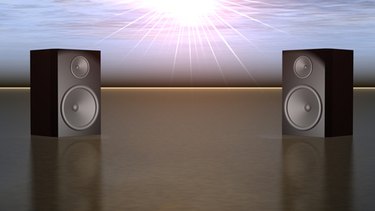
Passive speakers are speakers that lack an internal power source and draw all of their power from another component, usually an audio/video (A/V) receiver or an amplifier. Passive speakers lack internal amplification, as opposed to powered speakers, and they cannot produce sound when connected directly to an audio source such as a CD player. Power passive speakers by connecting them to a power source using speaker wire.
Step 1
Measure the amount of speaker wire needed to connect the speakers to the power source. Simply place the speakers in the desired location and set the end of the speaker wire spool underneath the speaker. Unspool the wire and run it to the power source, placing the speaker wire exactly where you plan on placing it when the connection is complete. Note that you may wish to add a few feet of extra speaker wire to accommodate for minor speaker position changes you might make in the future.
Video of the Day
Step 2
Remove 1/2-inch of the plastic covering on each end of the speaker wire, exposing the bare wire beneath. The ideal way to do this is with wire strippers designed for the gauge of the speaker wire. The gauge, or width, of the speaker wire is generally printed on the spool itself. To use wire strippers on speaker wire, simply place the wire into the appropriate sized slots in the wire stripper and gently pull the wire stripper towards the end of the speaker wire. If you do not have wire strippers, you can use scissors. Gently cut through the plastic coating on the outside of the speaker wire, doing your best not to cut through the wire itself.
Step 3
Connect one end of the speaker wire to the terminal on the back of the speakers. The two most common types of speaker wire terminals are tabs and circular connections. Tabs are holes for the speaker wire with a small color piece of plastic underneath, either red or black. Pressing on this piece of plastic opens the terminal and allows you to insert the wire. Circular connections use colored connectors that you need to turn counterclockwise by hand to reveal the terminal connections underneath. If you are unsure of how to connect speaker wire to your speakers, consult the owners manual for your speakers.
Step 4
Connect the other end of the speaker wire to the appropriate terminal on the power source. The positive (red) and negative (black) terminals connect to the same side of the speaker wire on both the speakers and the power source. Most speaker wire has some type of identification on one side of the wire such as the brand name or a red stripe to help you identify each side.
Video of the Day